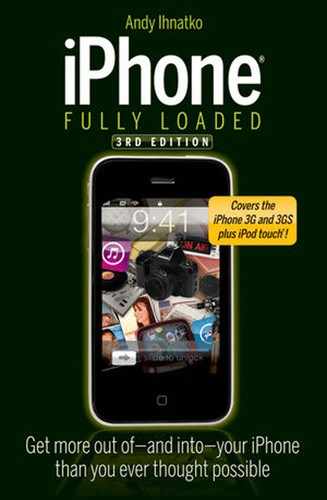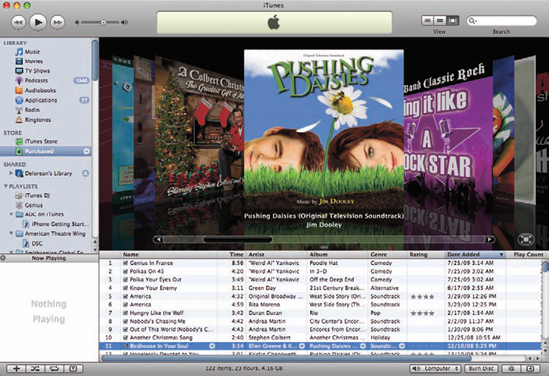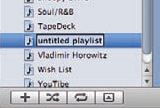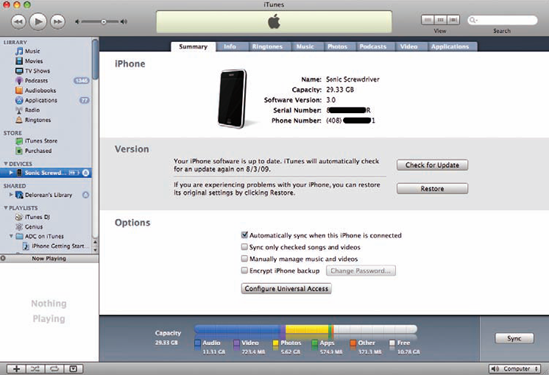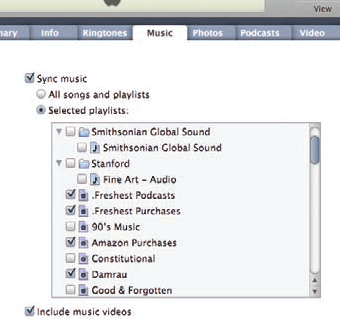The Skim
The Very Very (Very) Basics
Good heavens! I spent all that time in the introduction explaining that this book certainly isn't meant to be a ... For Dummies–style guide to the fundamentals of using the iPhone and iPod Touch. And now here I am, using the first chapter of the book to explain some of the fundamentals of using the iPhone and iPod Touch.
Blame my friend Roy. He broke my car.
Or at least, he let me break my car. Yes, the thing was 10 years old. Yes, it was pushing 100,000 miles. But I was looking after it very carefully and I'd expected to get another couple of years out of it. Just to be sure, I had my friend Roy teach me about basic maintenance. Roy was definitely the man to ask. He knows so much about cars that I imagine he has a second, ancillary brain down near his butt solely to store information about the correct tire pressure for hundreds of late-model sedans and SUVs.
He told me about the importance of checking the oil. "It's going to be leaking somewhere," he said, after walking me through the procedure. "If you don't know you're low on oil, you'll blow the engine and that's a career-ending injury even on a new car."
I followed his advice religiously. About two months later, I blew the engine.
It seems that when he told be about checking the oil, he neglected to point out the importance of being parked on a level surface. My house is on a big hill and apparently the dipstick was only reaching the deep end of the pool.
I am convinced that I am not an idiot. When I explain this to Roy, he usually asks for 10 minutes of airtime for partisan rebuttal.
The way I see it, this chapter is a win-win. The remainder of this book is peppered with phrases like "... and then add the file to your iTunes library" and "... just create a new, special playlist for this new content." If you don't already know all about iTunes, this chapter will save you a world of frustration. It'll also save me hours and hours of obsequious begging for you to please change the horrifically negative review you posted on Amazon.com after dead-ending somewhere around Chapter 2.
And if you already know iTunes inside and out ... well, I myself occasionally enjoy a good sneer as I skip over something I already understand well.
It's just never anything to do with cars, that's all. Not any more.
The one slight bummer about iPhones and iPods is that you, the humble hardworking user, are never allowed to access the device directly. Media phones and players made by other companies may be slightly tawdry, but they're like little hard drives. If you don't want to use a slick piece of software to manage the device's contents, you can just drag music and videos and other files into the thing manually. Even the stunningly shameless iPhone knock off I bought in China for $70 allows you to add content to the device this easily.
For a million reasons — some in your best interest, some not — Apple doesn't extend you that same courtesy. The iTunes app always, always, always acts as the gatekeeper. The iTunes app acts as a central library and file manager for all your media (see Figure 1-1). You tell iTunes what content from your desktop library you'd like to have on your device, and then iTunes does all the organizing and copying for you.
And when I say "always, always, always " of course I mean "not at all." But it's the only way to load up content into the iPhone's built-in music library. If you use an app like Air Sharing (praised in Chapter 20) or attach virtual network storage using any of the resources in that same chapter, your iPhone can see and play individual media files that live outside its own media library.
So to go from "a file on your hard drive" to "something you can enjoy on your iPhone," we have to walk this path:
Your iPhone will be updated with fresh content the next time you sync data between the phone and your desktop. If you select the Automatically Sync When this iPhone is Connected option in iTunes's settings panel for your phone (check out Figure 1-5 later in this chapter if you want a visual): Click the name of your iPhone in the left column of the iTunes window, and then click the Summary tab to reveal your phone's options, then the promise made by that simple checkbox label will be fulfilled whenever you plug in your iPhone. Otherwise, you can explicitly tell iTunes to update your phone by clicking the Sync button at the bottom of that same Options pane.
iTunes isn't a simple music player. It isn't an app that just plays a file off your hard drive and then forgets that it ever existed.
No, iTunes is grabby and ambitious: It's a Media Content Library Management System.
When you import a music or video file into iTunes, information about the file is added to a master database so that you can search for one song among thousands in an instant, just by providing a few details ("a seven-minute version of 'Anarchy in the U.K.,' recorded by Buddy Ebsen"). And unless you've explicitly told iTunes not to organize your library for you, iTunes also copies the file into its own special music directory when you add it to the library, instead of keeping your files scattered all over Creation.
Tip
When adding files to the limited you're not limited to just folders, either. If someone hands you a CD-R or a DVD-R loaded with media files, for instance, you can use your computer's file/ folder browser to select the entire volume. iTunes scrounges every file from the disc.
There are two different ways to add files to your iTunes library:
Choose File

Select a music or video file, or a folder containing music and videos.
Click the highlighted button. On a Mac, it'll be Choose. If you're selecting a file on a PC, it'll be OK, or Open if you're using the Add Folder command.
iTunes percolates for a minute. When it's done, all the selected files that iTunes knows how to deal with magically appear in the iTunes library.
If you're in Windows Explorer or the Mac Finder and you can see the name or icon of the files you want to import into iTunes, you can just drag the files straight into iTunes without any further ado. Drag them into the iTunes window, drag them into iTunes's desktop icon or its tile in the Windows taskbar or the Macintosh Dock. However you do it, if iTunes is equipped to handle that sort of file, a plus sign (+) appears next to your mouse pointer when you enter iTunes's airspace. Release the mouse button, and iTunes takes it from there.
Using playlists brings two big boons. Yes, it's handy to be able to instantly access a collection of songs that are tailor-made for workouts, meditation, or piloting your souped-up Dodge Charger down rural backroads at breakneck speeds with Boss Hogg in close pursuit. But it also helps you manage the problem of having more music and video on your desktop than you have space on your iPhone.
After all, the explicit goal of this book is to help you stuff that device until it's ready to a-splode. If you work your way through this book all the way to the back cover and you have no need for playlists, then I'll somehow feel as though I haven't done my job.
No refunds. Seriously. I've already spent every penny this book could ever hope to make.
You can create as many different play-lists as you like. iTunes offers two flavors of playlist: the plain-vanilla variety, through which you manually select specific music and video, and smart playlists, through which you simply describe the sort of music you'd like to hear, and trust iTunes to work out the specific details and fill the playlist on its own.
You can create a new playlist either by choosing File
Type in something a little more memorable. "Just Drive" is my usual playlist of stuff I want to hear in the car.
And that's really all there is to it. Any songs I drag into Just Drive will be added to the playlist, viz:
In the iTunes window Sources list, select Library. A list of all the music and video in your T i unes library appears.
Select one or more items from your library.
Drag them over the playlist's name.
Incidentally, when you copy items into a playlist the only thing you're actually copying is the items' information. All your actual music and video files remain where they were in iTunes's library, which means that any individual music track or video can be in many different playlists at once.
I mean, honestly: What sort of life would it be if you could only enjoy " the Cockroach that Ate Cincinnati" in one playlist at a time?
If you click on the playlist's name, iTunes's browser window switches to a view of the list of tracks therein. You can change the play order of those items by just dragging them around, or remove items by selecting the track and then hitting the Backspace or Delete key on your keyboard.
There are certain features of certain apps that make me want to stick five bucks in an envelope and mail it to the company. Smart playlists definitely comprise one of those features.
Smart playlists allow you to create a play-list without being specific about its contents. You describe the sort of content you want and iTunes automatically fills the play-list with stuff that matches that description. iTunes stores a lot of information about all of the items in its library — including how frequently and recently you've played each and every track — which means that it's easy to get iTunes to make some fairly sophisticated choices on your behalf.
For instance: I buy lots of music through the iTunes Music Store, representing all kinds of artists and genres. And every time I take my hour-long constitutional (I'd like to call it a "morning jog" but that would imply an ability to run faster than the average man can walk on his hands) I want to listen to my latest tunes.
I could either religiously move tracks in and out of a manual playlist every time I buy new music, or I can just define a smart playlist by choosing File
Each line represents a different "rule" to apply when choosing songs; To add a new one, I click the + button at the end of any rule. This smart playlist says:
After that list of rules, there's also a line where you specify how much music you'd like, and how you'd like iTunes to make the selection. One hour will do me just fine, though you can alternatively tell iTunes to limit by the number of songs or the amount of space the collection will take up. You might ask for 700 megabytes of music, which you can burn onto a CD and play in a rental car, for instance.
I've also told it to select the newest purchases. I could have asked iTunes to pick songs at random, songs that I haven't heard recently, or I could have chosen from an abundance of other options.
Once I click OK, the new playlist is automatically populated with items that match all of the rules I've laid out (see Figure 1-4). If you don't like some of the tracks the smart playlist chose (note that the playlist in Figure 1-4 features a lot of classical tracks), you can just select the offending items and tap the Delete or Backspace key to remove them from the playlist. They'll be replaced with alternative selections automatically.
Tip
You can automatically create a new playlist from a group of selected tracks in one step. On a Mac, you can simply drag the group into any empty spot in the Sources section of the iTunes window. If you're not dragging 'em into an existing playlist, iTunes just assumes that you want to make a new playlist with these items inside it. In the Windows edition, select a group of items and then choose File
And one of the (many) terrific features of smart playlists is that the list is "live." If for whatever reason a track inside a smart play-list no longer meets your list of rules, zap! It's removed from the playlist and replaced with one that does.
When I come home from my daily constitutional and re-dock my iPhone, iTunes discovers that all the tracks I listened to now fail the "hasn't been played in the past three days" test. So, by the time my iPhone is done syncing, those tracks in the Constitutional playlist have been replaced with all-new items. If I buy a few new tracks that evening, the three oldest tracks in the play-list are kicked out to make room for them.
(Exactly like the oldest contestants on Survivor.)
When you connect your iPhone to your computer, it automatically appears in iTunes's list of available devices. What happens after that depends on the iPhone options you've set. You can open the iPhone Options window by clicking your iPhone's name in the Devices section of the iTunes window. You wind up with a pane like the one you see in Figure 1-5.
If you leave the Automatically Sync When this Phone Is Connected box checked, iTunes will update the iPhone's contents automatically every time you plug it in.
There's another tweak to all of this: the Sync Only Checked Songs and Videos checkbox. Each music track and every video in every iTunes pane has a checkbox next to it. With this option enabled, any item that does not have its checkbox checked will not be synced to your iPhone. This makes it easy to "point and shoot" certain items that you never, ever, ever want to hear in the car.
Automatic updates take place only when you plug in your iPhone. You can also tell iTunes to "update this iPhone right freaking now " by clicking the Sync button. You'd do so if you've added new items or playlists to your iTunes library since plugging in your iPhone.
You'll note that the Options pane is organized into tabs. There's one for each different type of media that you can load up on your iPhone. Figure 1-6 shows you the Music tab.
Here's where you tell iTunes precisely which bits of your music (or video, or photo, or ...) library should be copied to your iPhone.
Take this moment to observe the All Songs and Playlists Option. Take a gooooood long look at it.
Ha ha! Yes, we all enjoyed a good laugh over that one. Unless you've just had your computer for 40 minutes, you already have way more music and video on your machine than you have free space on your iPhone, most likely. That's why iTunes allows you to narrow down the library to just an easily managed subset of playlists.
Tip
Be sure to check out Chapter 20. It contains some simple tricks and some exciting hardware, software, and service that can make the limited capacity of your iPhone or iPod Touch seem irrelevant.
Each pane is a little different, addressing the unique-ities of that kind of media. Video files tend to be humongous in their own right. An iPhone can handle a thousand songs, but a half a dozen movies can easily max out an 8-gigabyte model. So the Video tab lets you select individual shows or movies in addition to managing your content via playlists.
Automatic syncing is definitely the most whiz-bang approach. It makes you feel as though you're just days away from taking delivery on your own atomic-powered jetbelt.
But there's a second option for moving content onto your iPhone or iPod Touch. By clicking back onto the Summary tab of your iPhone's Options pane and then checking the Manually Manage Music and Video checkbox, you can tell iTunes to keep its mitts off your iPhone's library entirely. Nothing will land on that device unless you explicitly drag it onto your iPhone's icon in iTunes.
Yeah, that's definitely an option. Absolutely. I mean, speed, simplicity, and convenience are vastly overrated concepts. Besides, the automatic sync features burns as much fossil fuel in one year as an SUV does in an entire month.
(Source: Wikipedia, and I just added that fact a moment ago. So take it with a grain of salt.)
Managing content manually offers one pretty hefty advantage: It breaks the link between your iPhone and this one iTunes library. If you're visiting friends at their beach house and you're facing a two-hour drive home, you can simply plug your iPhone into your friend's computer and copy two hours' worth of fresh entertainment from your pals' iTunes library. Otherwise, only your "home" library has permission to add stuff to your iPhone.
Even the third edition of the iPhone OS shines a spotlight on iTunes's limitations. As of this writing, iTunes really isn't a universal gatekeeper for putting information on your iPhone or iPod Touch: just music, video, calendars, contacts, and photos. iTunes does help you manage all that stuff. Everything else is your own problem.
And as you start installing third-party apps, that shortcoming becomes more and more glaring. I expound later on about installing electronic books on your iPhone, for example. It's a natural; e-books are just as popular and abundant a type of media as music and video. But iTunes will have none of it. Instead, if Tess of the D'Urbervilles is going to plant her dainty behind in your phone, you'll need to acquire a third-party app to make it happen.
(Though by the time you read this, Apple might have added e-books to the iTunes Store. "Always in motion is the future," says Master Yoda.)
Apple has consistently bucked any possibility of allowing users and developers to use iTunes as a general concierge for all the data an iPhone user might want to manage. As a result, developers use all kinds of tricks to install user data.
If you're trying to put an MP3 of "Muskrat Ramble" on your phone, it travels along about three feet of USB cable strung between your computer and your iPhone. If you want a copy of a project outline, it doesn't matter that the same company made the desktop and iPhone also created the outline file and the iPhone app that reads it. It's possible that the file will have to travel out of your desktop, up across the Internet, into the software company's central server, and then from there back down to the iPhone that's sitting right on the damned keyboard.
Well, it works. Thank heavens. But there seems to be something punitive about such a complex answer to a simple question. I suppose I shouldn't complain. Problems like that are the reason why a book like this is necessary.
So that's the end of our first day of school. And now you see why we have all your little desks facing me instead of each other. This way, when the bell rings and you all flee into the hallways to whip out your phones and check in with Facebook, you can tell each other that this class was so lame, that you totally knew everything that Mr. Ihnatko discussed, that this is all so easy.
Meanwhile I'm the only one who saw the look on your face when I explained something elemental, and watched your eyes and ears go into full spread-spectrum capture mode. Funny, none of your friends seemed like they were learning something new. I bet they'd be really amused if they knew that you've had an iPhone since the very first day the first-generation hardware was available, and yet you didn't know how smart playlists worked.
To put it more simply: Those Hostess Cup Cakes your mom puts in your lunch come two to a pack. Send one my way from time to time and nobody ever needs to know about this. Capice?
